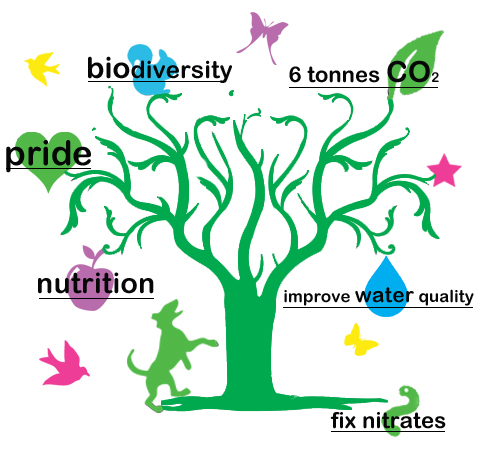
Stanza One
What does he plant who plants a tree? A
The poem begins with a Refrain clearly indicating what the poet wants to convey to the readers. The poet begins with a question which he repeats in every stanza. Here he not only asks the direct and immediate benefits of planting trees but also, he indicates the overall and indirect positive aspects of planting trees.
He plants a friend of sun and sky; B
In the second line, he goes on elucidating how planting a tree is akin to planting a friend of Sun and sky. When we plant a tree, we ensure abundant fresh air which helps us to a pollution free atmosphere with a productive rain cycle. Besides planting, trees will ensure healthy earth as it will help us protect the ozone layers obstructing the harmful rays from the sun.
· Figures of Speech used- Metaphor- He plants a friend
He plants the flag of breezes free; A
In the third line, the poet goes on stating the plant as a flag. He says that he who plants a tree will surely experience tree as a flag as in the strong breeze the branches and the leaves of the tree have a one-way move giving it the shape of a flag.

YOU MIGHT ALSO LIKE TO READ
· Figures of Speech used- Metaphor- Here the plant Is compared with a flag
· Figures of Speech used- Inversion- breezes free
The shaft of beauty, towering high; B
In the fourth line, the poet depicts the plant to be a shaft (pole) which is beautiful. The beauty of a plant is meaningful in many ways. A plant with greenery and a lot of fresh oxygen makes our environment aptly beautiful. Apart from that flowers, fruits, and other advantages which add to the beauty of the plant. Then the poet goes on about the height of the tree which he aptly compares with a Tower.
· Figures of Speech used- Metaphor – “The shaft of beauty” and “towering high”
He plants a home to heaven anigh; B
In the fifth line, the poet goes on describing how planting a tree could make you home and at the same time take you closer (anigh) to heaven.
· Figures of Speech used- Symbolism- Heaven- Sky.
· Figures of Speech used- Metaphor- Plant is compared to home
· Figures of Speech used- Inversion- to heaven anigh
For song and mother-croon of bird C
In the sixth line, the Poet goes on stating the earthly benefits of planting a tree. Planting a tree creates a favorable atmosphere for the beautiful singing birds to make their home and run their beautiful natural life.
· Figures of Speech used- Nil
YOU MIGHT ALSO LIKE TO READ
In hushed and happy twilight heard—C
In the seventh line, the poet focuses on the atmosphere when the birds serenade beautiful songs. The poet sets the time of twilight when the birds solemnize their divine home.
· Figures of Speech used- Alliteration- hushed and happy
· Figures of Speech used-Inversion- In hushed and happy twilight heard
· Personification- Here twilight has been attributed with a human quality.
· Transferred epithet- hushed and happy twilight

The treble of heaven’s harmony—A
In this stanza, the poet acquaints us with the holistic and beautiful aspect of nature. As adduced the poet considers planting a tree is like in close and serene harmony of nature. And this heavenly harmony is turned treble i. e. three times intense.
· Figures of Speech used- Alliteration- The treble/ heaven’s harmony
These things he plants who plants a tree. A
With this last line in the first stanza, the poet reiterates that planting a tree is just not planting a, it is something far more positive than that.
· Figures of Speech used- Alliteration- These things
Stanza Two
What does he plant who plants a tree? A
The first line of the second stanza reiterates the message that the poet wants us to remember. One who plants a tree is just not only planting a tree, rather much and much more vital and auspicious one.
· Figures of Speech used-Nil
He plants cool shade and tender rain, D
Now the poet makes us count on the benefits of planting a tree. One who plants a tree makes sure cool shade and tender rain. Here the poet reflects how planting trees are very vital for maintaining the ecosystem of the earth. Enough trees mean proper and abundant rainfall which makes the key vitality of this earth.
· Figures of Speech used-Periphrasis – He plants cool shade and tender rain
And seed and bud of days to be, A
The poet in this line further adds that how planting a tree will make sure the fertile land and prospect of sowing seed with lush growth and how later buds will come up ensuring the sustainability of the earth.
· Figures of Speech used-Climax- seed and bud
And years that fade and flush again; D
In this line, the poet goes on saying how this lush growth, germination would take place after the dry and scorching period of time. Here the poet basically indicates how the natural cycle of the year continues with every season dominating its part. However, he wants us not to forget that planting trees is the proper way to maintain this healthy cycle.
· Figures of Speech used- Alliteration- fade and flush

YOU MIGHT ALSO LIKE TO READ
He plants the glory of the plain; D
If we have to think of the glory of the plain area, then trees are the true glory of the plain for us. Because the very existence of us is possible if there is the existence of the trees. With oxygen, fruits, flowers, our food, and greenery make the plain beautiful in its true meaning.
· Figures of Speech used-Metaphor – Here the plants are compared with the glory of the plain.
He plants the forest’s heritage; E
In this line, the poet takes us to the understanding that a forestland perpetually sustains because of the new saplings taking over the old one carrying out the heritage of the forest
· Figures of Speech used-Metaphor – Here the plants are compared with the heritage.
The harvest of a coming age; E
The poet is here talking about the transition from tender youth to adulthood which is also a reference to the tree growing from a sapling into a tree.
· Figures of Speech used-Metaphor- Cycle of the plant is compared with the cycle of the humans
The joy that unborn eyes shall see—A
Here the poet reflects that the beauty and the enriching value of planting a tree will be joyously witnessed and appreciated by the unborn eyes that the posterity to come.
Figures of Speech used-
· Euphemism-Unborn Eyes meaning future generations.
· Alliteration- shall see

YOU MIGHT ALSO LIKE TO READ
These things he plants who plants a tree. A
With this last line in the second stanza, the poet reiterates that planting a tree is just not planting a, it is something far more positive than that.
Figures of Speech used-
· Alliteration- These things
Stanza Three
What does he plant who plants a tree? A
Even in the third stanza, the poet begins with the refrain stressing on the point of the importance of planting tree.
· Figures of Speech used- Nil
He plants, in sap and leaf and wood, F
Here the poet talks about the one who plants a tree is actually indicating and ensuring the auspicious, luscious and positive growth of the earth giving a healthy lease to the future generations.
Figures of Speech used-
· Climax- in sap and leaf and wood
In love of home and loyalty A
One who plants a tree does this for the sake of the love and loyalty to the near and dear ones.
This little but vital act of planting a tree make a man in the real sense.
· Figures of Speech used-Nil
And far-cast thought of civic good—F
One who plants a tree, he does it without any thought of self-benefit, and rather he considers it to be his civic duty to do good to the people of the society he is a part of.
· Figures of Speech used-Nil
His blessings on the neighborhood, F
One who plants a tree, he does it with a duty and responsibility to his neighbor.This act proves as the act of Blessing to his neighbor.
· Figures of Speech used-Nil
Who in the hollow of his hand G
Here the poet goes on appreciating the one who plants a tree because it is he who with his positive act brings development to the country.
· Figures of Speech used-Alliteration- his hand
Holds all the growth of all our land—G
It is he who plants a tree ensures the agricultural growth of the country thus ensuring the overall positive health of the land.
· Figures of Speech used-Nil
A nation’s growth from sea to sea A
One who plants a tree is the real hero of the nation, the most ideal one because it is he who takes the growth and glory of the nation from sea to sea indicating in different parts of the world.
· Figures of Speech used-· Alliteration- Sea to sea
Stirs in his heart who plants a tree. A
In the last line, the poet wants to convey that the key person for a country is the one who cares planting trees because this simple and noble act does the ultimate good to the country to the people in it.
· Figures of Speech used-
· Alliteration- his heart






